Our partner, XM, lets you access a free demo account to apply your knowledge.
No hidden costs, no tricks.

The world of finance is constantly evolving and keeping track of every minor change can be a major challenge for investors. Luckily, financial magazines with years of experience provide readers with thousands of interesting and insightful articles throughout the year. Choosing a financial magazine can be a bit more challenging than it sounds. With dozens of magazines competing for the spot as the go-to platform for economic and financial news, readers might find it hard to compare them and clearly visualize which one holds the competitive edge.
Financial magazines differ by their focus on economic sectors, availability of print/digital media, price, issue frequency, etc.
Investors may not have much time on their hands to read through hundreds of pages and dozens of articles from different sources, preferring to stick with a reliable, respected financial magazine with decades of experience.
If you would like to find out which financial magazine best fits your areas of interest - this Investfox article is for you.
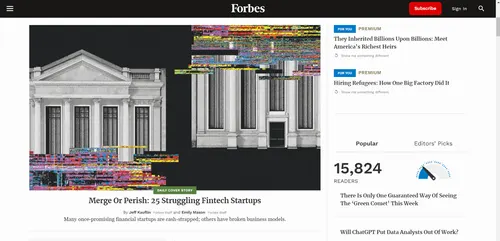
Forbes Magazine is one of the better-known financial and economic magazines in the world. Launched in the United States, the magazine dates back to as early as 1917. The magazine covers a broad range of topics, such as economics, technology, business, finance, innovation, politics, etc.
The print version of the magazine is released twice a quarter. Forbes offers a variety of periodicals, including Forbes 400, 30 Under 30, Forbes Billionaires, etc.
“My number one goal is to make Forbes the best place to work in media" - Mike Federle
The core subscription costs $29.99/year and $9.99 for single issues. Forbes is also available worldwide in 27 countries in both print and digital versions.
Forbes focuses on different subsectors of the global economy, different industries, innovation, technological advancements, etc. Forbes articles include topics of different scopes and target audiences, which allows the magazine to have a broad reader base.
An annual subscription to Forbes grants access to unlimited digital access to Forbes articles, breaking news, analysis pieces, fewer ads, and exclusive, members-only events.
An annual Forbes subscription costs $29.99 and readers can choose a monthly subscription for $6.99, or a two-year subscription for $69.99.
Forbes also offers a discounted rate for students and users can email the magazine and request a group subscription.
New readers can read four Forbes articles for free and can cancel their monthly subscription at any time.
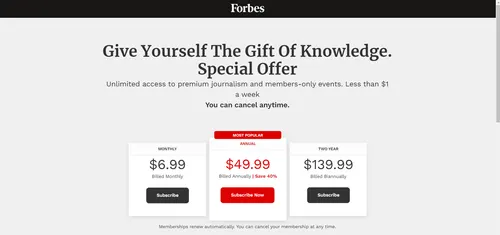
The Forbes magazine is one of the most well-respected magazines covering a wide range of topics, including finance, economics, technology, innovation, art, etc.
The monthly subscription for the digital magazine is relatively affordable at $6.99, with a breadth of insightful content and the flexibility to cancel at any time and stick with the digital-only version.
However, for readers who are interested in more investment-centric content covering niches, asset classes, and events, Forbes may not be their first choice, as the magazine targets a wider audience and focuses on headlines that can grab the most attention.
Nonetheless, for investors who wish to gain access to well-rounded, bipartisan financial news, Forbes is more than a solid option, at an affordable price of just $29.99/year.
As for the print magazine, each issue will set them back $9.99, with each issue covering a wide range of topics.

Reuters is another well-regarded and trusted financial magazine that focuses on the world of finance and economics, business news, industry, technological developments, and investments.
Reuters offers its content for free to a broad range of readers and offers a separate, premium tier for industry professionals at $34.99/month. The primary source of revenue for Reuters has been the licensing of content and media to third parties, such as media and financial analysis agencies, as well as institutional clients. Reuters is a subsidiary of the Thomson Reuters Corporation, which is traded on the Toronto and New York stock exchanges.
“We [!reuters!] are the largest news organization in the world we reach over a billion people every day everywhere in the world" - Stephen Adler
As already mentioned, Reuters does not charge for a bulk of its articles, but reserves some of its expert research for industry professionals, at $34.99/month.
The core content covers a very wide range of news and developments, primarily from finance, technology, and other economic sectors.
Reuters divides its content into eight different categories:
Reuters also offers a bookstore, which includes hundreds of books for law professionals and students.

Reuters is one of the most trusted news outlets in the world, with cutting-edge investigative journalism and market insights, Reuters has cemented itself as one of the most reliable sources of financial news available on the market today.
An added bonus to this is the fact that Reuters is free and readers only have to pay for the premium subscription, which is geared towards industry professionals with years of experience.
Reuters has a diverse catalog of articles and divides its content into manageable sections, which include news from global markets, businesses, consumer trends, major economic shifts, etc.
Reuters is a well-balanced news source with a focus on the global economy, new developments, and policy. All of this at no upfront cost makes Reuters one of the most attractive options for the investing community.
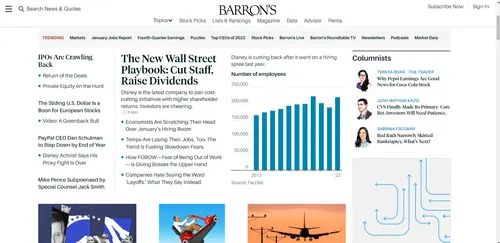
Barron’s is one of the prime destinations for investment-minded individuals, with insightful articles, investment analysis, charts, market data, and everything an investor may need to make informed decisions on the market. Barron’s typically specializes in stocks and provides thorough analyses of individual stocks, as well as stock sectors. The magazine has long been the prime destination for equity investors, but Barron’s does not limit its output to just stocks. Barron’s dates back to 1921 and includes a print newspaper, as well as a digital portal, which is the primary source of revenue for the company.
The base account for Barron’s goes for $4.99/month and the first month is a free trial, which can be canceled at any time. Barron’s features daily market news, including top-performing and most active stocks and ETFs. Users have access to a wide range of analytical articles, including stock picks and overperformers.
Barron’s offers its Picks & Pans section, which allows users to view the past performance of Barron’s stock picks.
While Barron’s provides a breadth of articles and expert stock analysis, it does not offer more technical tools, such as charting and technical analysis, or support for portfolio analysis tools. Furthermore, Barron’s is geared more towards an active, experienced investor, rather than a complete beginner, which can be an issue for someone just starting out in the world of finance.
The full digital subscription to Barron’s costs $19.99/month or $239.88/year. The digital and print bundle costs $29.99/month or $359.88/year. Considering the fact that Barron’s is not the most beginner-friendly platform, the subscription prices may be steep for total beginners.
Barron’s also offers a newsletter, podcasts, and MarketBrief, which is an easily-digestible financial news roundup. Users also have access to video briefs, mutual funds screeners, as well as a user-friendly website design.

While Barron’s is known for insightful market analysis with a focus on stocks and ETFs, the platform is less beginner-friendly than many other financial magazines. Despite this, Barron’s offers plenty of content, which may be attractive for the more established investor, and reliable stock analysis can be attractive enough to warrant the relatively high price of the magazine.
The Economist has been one of the longest-standing financial magazines in the world. First launched in 1843, the Economist magazine places a focus on the global macroeconomic climate and its effects on economic subsectors. The Economist is known for its thorough analysis of global trends, as well as their effects on individual companies and sectors of the economy. Readers can access the Economist through an online subscription, or as print media.
The Economist is a leading global economic magazine with insights from industries all over the world. Government policy, major legislative changes, international relations, and the macroeconomic climate are all at the forefront of the Economist’s coverage.
The Economist offers different subscription deals, which are subject to New Year’s discounts:
All of The Economist’s content is also available in audio format and podcasts are also available.
Readers can gift a subscription to their friends and group subscription options are also offered. Students and educators can apply for an academic discount.
The Economist is geared towards readers who wish to be on top of broad-market news to protect and expand their wealth and knowledge of the global economy.
The Economist is a great option for active investors and industry professionals who wish to be on top of global economic news as they develop. At $19.90/month, The Economist can be a bit steep for the average reader. However, the unparalleled experience and global reach make The Economist one of the most renowned and trusted financial magazines in the world, with the total subscriber count exceeding 1.6 million.

Bloomberg Businessweek is a business magazine offered by Bloomberg, which also offers a broad range of market products, such as analytical pieces and The Bloomberg Terminal.
The Bloomberg Businessweek offers insights into the world of management and business, with hundreds of articles covering the world of business and investments.
The Bloomberg Businessweek can be broken down into segments, such as:
Businessweek is a well-rounded publication that covers a wide range of topics and is included in the Bloomberg subscription deal:
The full Bloomberg subscription grants access to thousands of Bloomberg articles, 24/7 Bloomberg TV, exclusive newsletters, live radio, podcasts, and narrated articles, as well as Bloomberg Businessweek.
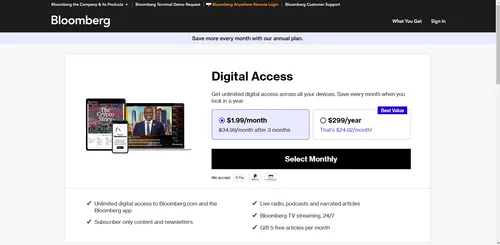
Bloomberg Businessweek is a well-rounded, albeit somewhat sensationalist, business magazine that covers news from all around the world of business and finance and is included in the overall Bloomberg subscription. While a Bloomberg subscription might be a bit steep, it does come with a hefty amount of content - articles, podcasts, live TV, etc. Being one of the most recognizable names in the industry, Bloomberg can be an important addition and a good value for money to the everyday investor.

The Financial Times is a British daily business newspaper that dates back to 1888. The newspaper is now offered in print format, as well as a monthly/yearly subscription with thousands of articles related to business, finance, policy, technology, etc.
Readers can choose between a fully digital platform or an ePaper subscription, which comes with the digital versions of the print newspaper.
The Financial Times has emerged as one of the most popular financial newspapers in the UK and globally.
The Financial Times greets readers with a sleek, easy-to-navigate website, which divides the newspaper’s content into distinct categories, such as:
The Financial Times offers several subscription packages, including:
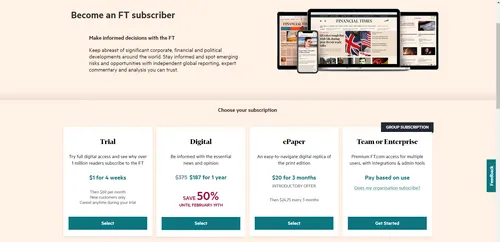
The Financial Times is one of the oldest financial newspapers in the world and offers a wide variety of insightful articles. However, the subscription might be a bit too steep for most readers and their articles do not offer their picks or recommendations, either.
“So the FT (Financial Times), traditionally, has not covered a lot of
social news, or news about systematic racism or diversity, and that is something that has been changing over time." - Roula Khalaf
Whether to subscribe to the Financial Times or not depends on the budget of the reader and their intended use of the vast selection of content available on the Financial Times website and print newspapers.

Kiplinger’s Personal Finance magazine is one of the top choices for investment-minded individuals. The magazine was launched in 1920 and has since published thousands of articles on personal finance and business forecasts.
Kiplinger’s is published on a monthly basis and includes articles about taxes, small businesses, insurance, and retirement.
Kiplinger's Personal Finance magazine includes monthly print and digital articles, as well as the “Kiplinger’s Tax Letter” which is a tax planning and retirement newsletter for individuals who want to make sure that they are handling their taxes properly.
Kiplinger’s has also unveiled another complementary service called “Kiplinger’s Alerts”, which sends action signals to the user’s computer or mobile phone.
Kiplinger’s articles cover a broad range of topics, including retirement, wealth building, investments and portfolio management, taxes, and more.
Kiplinger’s subscriptions are available separately as print and digital mediums, as well as a bundle. The pricing of the magazine remains the same at $29.95/year or $49.95 for a two-year subscription.

Kiplinger’s is an interesting alternative for readers who already have a degree of savings under their name and would like to stay on top of the market and pick the best long-term investments to meet their objectives. The magazine might not be as attractive for younger investors with a higher appetite for risk, as Kiplinger’s focuses more on tax planning and retirement than speculative, novel assets. The subscription cost might be somewhat steep for some users as well.
The modern-day investor has a lot of options when it comes to gathering information from the world of finance and major financial magazines are here to help. With decades of experience under their belt, financial magazines such as Forbes, The Economist, and The Financial Times, among others, have stood the test of time and transitioned seamlessly into the digital age.
Readers also enjoy many other perks from a subscription, such as various newsletters, recommendations, subscriber-only events, etc.
One thing that every rational investor or anyone interested in the world of finance needs to consider is the cost associated with such subscriptions, especially if you are managing a few at once. The prices of each can be a bit high for some readers, therefore, it is important to consider your budget and the value for money you are likely to gain from a subscription. Subscribing to a financial magazine is also an investment, after all.
Our partner, XM, lets you access a free demo account to apply your knowledge.
No hidden costs, no tricks.
Financial magazines can be a good source of information for readers who are interested in the world of business, finance, and economics. Many financial magazines include analyst coverages, which contain valuable information about a particular topic.
No, Bloomberg is not a financial magazine, but it does offer a magazine called Bloomberg Businessweek, which is included in the Bloomberg subscription packages.
There are dozens of financial magazines on the market. Notable ones include the likes of Forbes, The Financial Times, The Economist, Bloomberg Businessweek, etc.